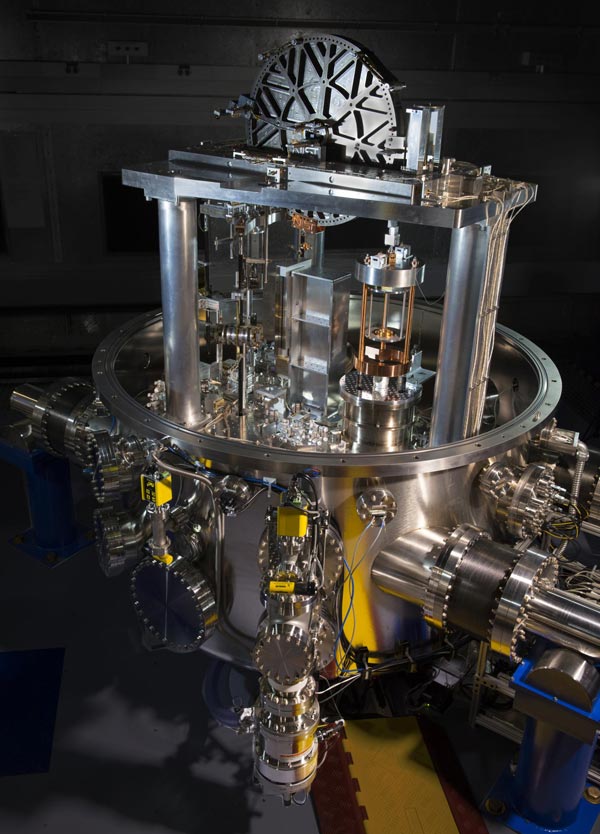Measuring Planck's constant, NIST's watt balance brings world closer to new kilogram

The NIST-4 watt balance has measured Planck's constant to within 34 parts per billion, demonstrating that the high-tech scale is accurate enough to assist with 2018's planned redefinition of the kilogram. Credit: J. L. Lee/NIST
The redefinition-which is not intended to alter the value of the kilogram's mass, but rather to define it in terms of unchanging fundamental constants of nature-will have little noticeable effect on everyday life. But it will remove a nagging uncertainty in the official kilogram's mass, owing to its potential to change slightly in value over time, such as when someone touches the metal artifact that currently defines it.
Planck's constant lies at the heart of quantum mechanics, the theory that is used to describe physics at the scale of the atom and smaller. Quantum mechanics began in 1900 when Max Planck described how objects radiate energy in tiny packets known as “quanta.”
The amount of energy is proportional to a very small quantity called h, known as Planck's constant, which subsequently shows up in almost all equations in quantum mechanics. The value of h – according to NIST's new measurement – is 6.62606983×10-34 kg?m2/s, with an uncertainty of plus or minus 22 in the last two digits.
Accurate measurement of this tiny number is the key to retiring the physical kilogram, because it provides a way to equate mass with a particular amount of electric energy, which can be expressed as a function of h. If we know h precisely, we can build an electromagnet and measure exactly the amount of electric current it needs to lift a kilogram off the ground, and define the kilogram in terms of the current.
Scientists are putting this idea to work in a device called the watt balance, which compares a physical mass with finely measured amounts of electricity (see this story for details of how watt balances work).
With enough accurate measurements of Planck's constant, scientists will eventually fix its value to a very high degree of precision, allowing highly accurate measurements of the kilogram. For scientists to agree on a new mass definition that relies on Planck's constant, however, there must be solid evidence that we know h to great accuracy, so multiple countries–five to date – have built watt balances to make independent measurements that can be compared.
NIST's measurement, the first using its recently constructed NIST-4 watt balance, is good news because it is consistent with watt balance measurements from other countries and also because the amount of uncertainty in the measurement is far lower than the NIST team had hoped for. Both points imply that the international science community is on track to redefine the kilogram by its self-imposed 2018 deadline.
“This measurement was essentially a dry run,” said NIST physicist Stephan Schlamminger. “We were hoping to achieve an uncertainty of within 200 parts per billion by this point, but we got better fast.”
For the redefinition to meet scientists' exacting standards, at least three experiments must produce values with a relative standard uncertainty of no more than 50 parts per billion, and one with no more than 20 parts per billion. All these values must agree within a statistical confidence level of 95 percent. The results also must be reconciled with the alternative “Avogadro” method, which involves counting the atoms in an ultra-pure sphere of silicon.
Because Planck's constant is important for quantum electrical standards, the overall effort also will benefit electrical metrology, Schlamminger said. Fixing h's value will explicitly connect the quantum based standards for the ohm and the volt to the international system of units for the first time.
###
*D. Haddad, F. Seifert, L.S Chao, S. Li, D.B. Newell, J.R. Pratt, C. Williams, and S. Schlamminger. A precise instrument to determine the Planck constant, and the future kilogram. Review of Scientific Instruments. June 21, 2016. DOI: 10.1063/1.4953825. Link: https:/
Media Contact
All latest news from the category: Physics and Astronomy
This area deals with the fundamental laws and building blocks of nature and how they interact, the properties and the behavior of matter, and research into space and time and their structures.
innovations-report provides in-depth reports and articles on subjects such as astrophysics, laser technologies, nuclear, quantum, particle and solid-state physics, nanotechnologies, planetary research and findings (Mars, Venus) and developments related to the Hubble Telescope.
Newest articles

Sea slugs inspire highly stretchable biomedical sensor
USC Viterbi School of Engineering researcher Hangbo Zhao presents findings on highly stretchable and customizable microneedles for application in fields including neuroscience, tissue engineering, and wearable bioelectronics. The revolution in…

Twisting and binding matter waves with photons in a cavity
Precisely measuring the energy states of individual atoms has been a historical challenge for physicists due to atomic recoil. When an atom interacts with a photon, the atom “recoils” in…

Nanotubes, nanoparticles, and antibodies detect tiny amounts of fentanyl
New sensor is six orders of magnitude more sensitive than the next best thing. A research team at Pitt led by Alexander Star, a chemistry professor in the Kenneth P. Dietrich…





















